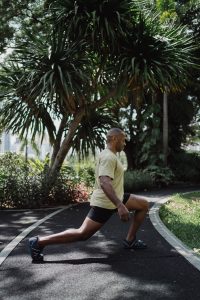
Lunges are a classic exercise used to build strength and power in the legs, as well as improve balance and stability. But how many times have you tried lunges only to find yourself feeling awkward and unsure of the correct form? Lunges can be tricky, but with proper technique and practice, they can be a powerful tool in your exercise arsenal.
Benefits of lunges
Lunges are one of the most popular exercises for toning and strengthening the lower body, but they have many other benefits as well. Lunges can help improve balance and flexibility, as well as improve posture and core strength. And, since lunges are a bodyweight exercise, you can do them anywhere without the need for expensive equipment or a gym membership.
There are many benefits to incorporating lunges into your regular exercise routine. Here are just a few:
1. Improved Balance
Lunges are a great way to improve balance and coordination. Since lunges require you to balance on one leg and then shift your weight while you move, they help to strengthen the muscles that keep you upright and help you move gracefully. This can help to reduce the risk of falls and injuries.
2. Improved Flexibility
Lunges help to stretch and improve the range of motion in your hips, legs, and back. This can help to reduce stiffness and improve overall flexibility. Flexibility is especially important for athletes and those participating in activities such as yoga or martial arts. With increased flexibility, you will be able to move more freely and reduce the risk of injury.
3. Improved Posture
Lunges help to strengthen the muscles that are responsible for good posture. When done correctly, lunges can help to strengthen the core and muscles in the upper back that are responsible for keeping your spine straight and your shoulders back. This can help to improve your posture and reduce strain on your neck and shoulders.
4. Improved Core Strength
Lunges are a great way to strengthen your core. As you lunge forward, your core muscles work to maintain your balance and stability. This helps to improve core strength, which can in turn improve posture and reduce back pain.
5. Reduced Risk of Injury
By improving balance, flexibility, posture, and core strength, lunges can help reduce the risk of injury. Stronger muscles are better equipped to handle the stress of everyday activities and reduce the risk of becoming injured.
How To Do Lunges Correctly
It’s important to make sure you’re doing them correctly in order to maximize your results and avoid injury.
The first step when doing lunges is to make sure you have the right stance. You want to start with your feet shoulder-width apart and your toes pointing forward. Then, take a large step forward with one foot, making sure to keep your toes pointing forward. As you step forward, you want to begin to lower your body by bending both knees until your back knee almost touches the ground. Make sure that your front knee does not pass your toes and that your back heel does not come off the ground.
Once you have reached the bottom of the lunge, you’ll want to keep your torso upright and your core engaged. This will help prevent any strain on your lower back. Then, you’ll want to push up through your front heel and drive your back leg up to return to the starting position. Make sure to keep your torso upright and your core engaged throughout the entire movement.
When it comes to adding weights to your lunges, you’ll want to begin with lighter weights until you feel comfortable with the form and movement. You can do this by holding a dumbbell or plate in each hand at chest height while you lunge. This will help you to better control your movements and ensure you’re doing the exercise correctly. When you feel comfortable with the form and the weight, you can then start to increase the weights.
Now that you know how to do lunges correctly, it’s important to warm up and stretch before and after each session. This will help prevent injury and help you get the most out of your workouts.
Variations of Lunges
There are many different variations on the lunge, each of which provides a slightly different challenge to your muscles. Here’s a look at some of the more popular and effective variations:
1. Reverse Lunge: This is the most common lunge variation and it works your glutes, quads and hamstrings. To do it, stand with your feet hip-width apart, and then step backwards with one leg and lower your body until your knee is bent at a 90-degree angle. You should feel the tension in your leg that is stepping backwards. Push off with your back leg to return to the starting position.
2. Curtsy Lunge: This variation works the same muscles as the reverse lunge, but it also challenges your balance and coordination. To do it, stand with your feet hip-width apart and then cross one leg behind the other, as if you were curtsying. Hinge forward as you lower your body until your front knee is bent at a 90-degree angle. Push off with your rear leg to return to the starting position.
3. Split Squat: This variation is similar to the reverse lunge, except your feet are placed further apart. Start by standing with your feet staggered, with one foot about three feet in front of the other. Bend your front knee until your thigh is parallel to the ground, and then push off your front foot to return to the starting position. This variation works your quads, glutes and hamstrings.
4. Step-up: This variation works your quads, glutes and hamstrings. To do it, stand with your feet hip-width apart and then step up onto a raised platform with one foot. Make sure your foot is firmly planted on the platform and then drive through the heel of your front foot to return to the starting position.
5. Walking Lunge: This variation is great for improving your balance and coordination. To do it, stand with your feet hip-width apart and then step forward with one leg. Lower your body until your knee is bent at a 90-degree angle and then drive through your heel to bring your rear leg forward. Keep alternating your legs and lunging forward to “walk” your way across the room.
These are just a few of the more popular lunge variations. By incorporating different variations into your workout routine, you can challenge your muscles in new ways and prevent boredom.

Scientific Research on Lunges
Recent scientific research has found that lunges can be used to improve strength, balance, and flexibility. A study published in the Journal of Strength and Conditioning Research tested the effects of lunges on lower body strength and balance. The researchers found that lunges increased lower body strength and balance in the participants.
Another study published in the Journal of Sports Medicine and Physical Fitness tested the effects of lunges on flexibility. The researchers found that lunges could improve hip and knee flexibility in participants.
Lunges can also help reduce the risk of injury. A study published in the journal Medicine & Science in Sports & Exercise found that lunges can reduce the risk of anterior cruciate ligament (ACL) injury in athletes. The researchers found that athletes who performed a specific type of lunge exercise were less likely to suffer an ACL injury than those who did not perform the exercise.
Lunges can also help improve cardiovascular health. A study published in the journal Applied Physiology, Nutrition, and Metabolism found that lunges can increase blood flow to the muscles, which can improve cardiovascular health.